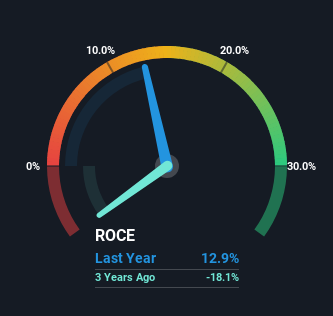Investors Will Want Namura Shipbuilding's (TSE:7014) Growth In ROCE To Persist

To find a multi-bagger stock, what are the underlying trends we should look for in a business? One common approach is to try and find a company with returns on capital employed (ROCE) that are increasing, in conjunction with a growing amount of capital employed. Basically this means that a company has profitable initiatives that it can continue to reinvest in, which is a trait of a compounding machine. With that in mind, we've noticed some promising trends at Namura Shipbuilding (TSE:7014) so let's look a bit deeper.
What Is Return On Capital Employed (ROCE)?
For those who don't know, ROCE is a measure of a company's yearly pre-tax profit (its return), relative to the capital employed in the business. Analysts use this formula to calculate it for Namura Shipbuilding:
Return on Capital Employed = Earnings Before Interest and Tax (EBIT) ÷ (Total Assets - Current Liabilities)
0.13 = JP¥11b ÷ (JP¥156b - JP¥67b) (Based on the trailing twelve months to December 2023).
Thus, Namura Shipbuilding has an ROCE of 13%. On its own, that's a standard return, however it's much better than the 7.9% generated by the Machinery industry.
See our latest analysis for Namura Shipbuilding

While the past is not representative of the future, it can be helpful to know how a company has performed historically, which is why we have this chart above. If you want to delve into the historical earnings , check out these free graphs detailing revenue and cash flow performance of Namura Shipbuilding.
So How Is Namura Shipbuilding's ROCE Trending?
Shareholders will be relieved that Namura Shipbuilding has broken into profitability. The company was generating losses five years ago, but has managed to turn it around and as we saw earlier is now earning 13%, which is always encouraging. While returns have increased, the amount of capital employed by Namura Shipbuilding has remained flat over the period. With no noticeable increase in capital employed, it's worth knowing what the company plans on doing going forward in regards to reinvesting and growing the business. So if you're looking for high growth, you'll want to see a business's capital employed also increasing.
Another thing to note, Namura Shipbuilding has a high ratio of current liabilities to total assets of 43%. This effectively means that suppliers (or short-term creditors) are funding a large portion of the business, so just be aware that this can introduce some elements of risk. Ideally we'd like to see this reduce as that would mean fewer obligations bearing risks.
The Bottom Line On Namura Shipbuilding's ROCE
To sum it up, Namura Shipbuilding is collecting higher returns from the same amount of capital, and that's impressive. Since the stock has returned a staggering 444% to shareholders over the last five years, it looks like investors are recognizing these changes. With that being said, we still think the promising fundamentals mean the company deserves some further due diligence.
One more thing to note, we've identified 1 warning sign with Namura Shipbuilding and understanding this should be part of your investment process.
While Namura Shipbuilding may not currently earn the highest returns, we've compiled a list of companies that currently earn more than 25% return on equity. Check out this free list here.
Valuation is complex, but we're here to simplify it.
Discover if Namura Shipbuilding might be undervalued or overvalued with our detailed analysis, featuring fair value estimates, potential risks, dividends, insider trades, and its financial condition.
Access Free AnalysisHave feedback on this article? Concerned about the content? Get in touch with us directly. Alternatively, email editorial-team (at) simplywallst.com.
This article by Simply Wall St is general in nature. We provide commentary based on historical data and analyst forecasts only using an unbiased methodology and our articles are not intended to be financial advice. It does not constitute a recommendation to buy or sell any stock, and does not take account of your objectives, or your financial situation. We aim to bring you long-term focused analysis driven by fundamental data. Note that our analysis may not factor in the latest price-sensitive company announcements or qualitative material. Simply Wall St has no position in any stocks mentioned.
About TSE:7014
Namura Shipbuilding
Engages in the manufacture and sale of ships, machinery, and steel structures worldwide.
Outstanding track record with flawless balance sheet.


